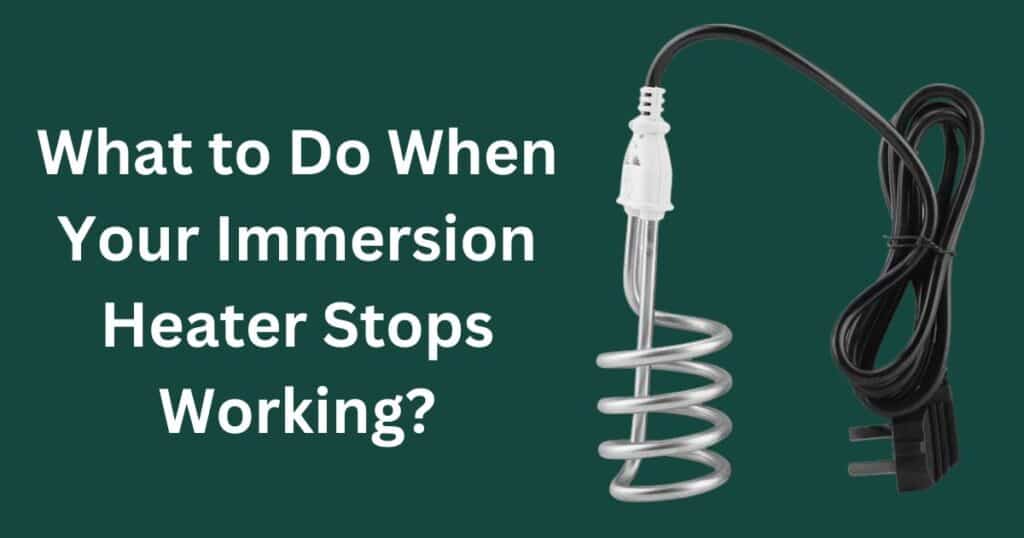What Is an Immersion Heater?
An immersion heater is a crucial component in water heating systems, responsible for providing hot water in homes, businesses, and industrial settings. It’s a simple yet effective device that consists of an electric heating element directly submerged in the water tank or container.
This design allows for efficient heat transfer, as the heating element comes into direct contact with the water, rapidly raising its temperature.
Immersion heaters are commonly found in storage tanks, water heaters, boilers, and other hot water systems. They are popular for their reliability, energy efficiency, and ability to heat large volumes of water quickly.
Whether you need hot water for household tasks like showering, washing dishes, or laundry, or for industrial processes like manufacturing or cleaning, an immersion heater is often the go-to solution.
How Does an Immersion Heater Work?
The basic principle behind an immersion heater’s operation is electrical resistance. When an electric current passes through the heating element, it encounters resistance, which generates heat. This heat is then transferred directly to the surrounding water, raising its temperature.
Most immersion heaters are controlled by a thermostat, which regulates the temperature and prevents overheating. The thermostat monitors the water temperature and cycles the heating element on and off as needed to maintain the desired temperature.
Here’s a step-by-step breakdown of how an immersion heater works:
- The immersion heater is installed in the water tank or container, with the heating element fully submerged in the water.
- When the thermostat detects that the water temperature has dropped below the set point, it activates the heating element by allowing an electric current to flow through it.
- As the electric current encounters resistance in the heating element, it generates heat through the principle of electrical resistance.
- This heat is then transferred directly to the surrounding water, raising its temperature.
- Once the water reaches the desired temperature, the thermostat cuts off the electric current to the heating element, preventing further heating.
- As the hot water is used and the temperature drops again, the thermostat reactivates the heating element, and the cycle repeats.
This simple yet effective process ensures a reliable supply of hot water whenever it’s needed.
How Long Does an Immersion Heater Take to Heat Water?

The time it takes for an immersion heater to heat water can vary depending on several factors, including:
- Wattage of the heating element: Higher wattage means more heat output and faster heating.
- Volume of water: A larger volume of water will take longer to heat than a smaller volume.
- Desired temperature increase: The greater the desired temperature increase, the longer it will take to heat the water.
- Insulation of the tank or container: Better insulation helps retain heat, reducing the heating time.
Generally speaking, a standard residential immersion heater with a wattage between 1,500 and 3,000 watts can heat a full tank of water (around 40-50 gallons) in 1-2 hours, assuming a temperature increase of around 50-60°F (28-33°C).
Here’s a rough estimate of heating times for a 40-gallon (151-liter) water tank with different wattage immersion heaters:
WattageHeating Time (approx.)1,500 watts2 hours2,000 watts1.5 hours3,000 watts1 hour
Keep in mind that these are approximate values, and actual heating times may vary based on the specific conditions and factors mentioned above.
Why Do I Have No Hot Water?
If you find yourself without hot water, it’s likely that your immersion heater is not functioning correctly. There could be several reasons for this, which we’ll explore in the next section.
Read More: An Exclusive Look Inside Joe Burrow’s Lavish House: The NFL Star’s Million-Dollar Mansion
Top 5 Causes for an Immersion Heater Not Heating Water
When your immersion heater stops heating water, it’s important to identify the root cause to determine the appropriate solution. Here are the top five reasons why an immersion heater may not be heating water effectively:
1. Limescale Buildup
Over time, mineral deposits from hard water can accumulate on the heating element, forming a layer of limescale. This buildup acts as an insulator, preventing efficient heat transfer and reducing the heater’s effectiveness.
Hard water areas are particularly prone to limescale buildup, and regular descaling is essential to maintain optimal performance. Neglecting this maintenance can lead to decreased heating efficiency, higher energy consumption, and potentially premature failure of the heating element.
2. Faulty Thermostat
The thermostat is responsible for regulating the temperature of the water. If it malfunctions, it may not accurately detect the water temperature or signal the heating element to turn on or off appropriately, resulting in lukewarm or no hot water.
A faulty thermostat can cause the heating element to cycle on and off erratically or fail to activate at all, leading to inefficient heating or a complete lack of hot water.
H3: 3. Damaged or Faulty Immersion Element
The heating element itself can become damaged or faulty due to age, overheating, or electrical issues. A damaged element will struggle to generate sufficient heat, leading to subpar water heating or complete failure.
Over time, constant exposure to heat and electrical currents can cause the heating element to degrade or burn out, requiring replacement. In some cases, a manufacturing defect or external damage can also render the heating element inoperable.
4. Insulation Issues
Proper insulation is crucial for maintaining the water temperature in the tank or heater. If the insulation is damaged or inadequate, heat can escape, causing the water to cool down quickly and forcing the immersion heater to work harder, potentially leading to premature failure.
Inadequate insulation not only affects the heating efficiency but can also result in higher energy costs, as the heater needs to work harder to compensate for the heat loss.
Tripped Breaker
In some cases, a tripped circuit breaker can cut off the power supply to the immersion heater, preventing it from functioning. This can happen due to an electrical fault, overload, or other issues with the electrical system.
If the circuit breaker has tripped, the immersion heater will not receive the necessary electrical current to generate heat, resulting in a complete lack of hot water.
What are the Signs of the Immersion Heater Not Working?
While a lack of hot water is the most obvious indication that your immersion heater is not functioning properly, there are other signs to watch out for:
No Hot Water
The most glaring sign of an immersion heater problem is a lack of hot water. If you turn on the hot water tap and only cold water comes out, it’s a clear indication that the heater is not functioning correctly.
Unusual Sounds or Noises
Immersion heaters should operate quietly. If you hear strange noises, such as popping, crackling, or humming, it could signify a problem with the heating element or other internal components.
These noises may indicate issues like limescale buildup, damaged heating elements, or electrical faults, and should be addressed promptly.
Water Not Heating to Desired Temperature
If the water is not reaching the desired temperature, even after extended heating periods, it might be a sign that the immersion heater is not operating at full capacity or has a thermostat issue.
In this case, the heating element may be partially functioning, but not providing enough heat to raise the water temperature to the desired level.
Common Causes of Immersion Heater Malfunctions
Immersion heaters can malfunction due to various reasons, some of which are:
Tripped Circuit Breakers
As mentioned earlier, a tripped circuit breaker can cut off power to the immersion heater, causing it to stop working. This can happen due to electrical faults, overloads, or other issues with the electrical system.
If the circuit breaker has tripped, resetting it may temporarily restore the heater’s functionality, but it’s essential to identify and address the underlying cause to prevent repeated tripping.
Faulty Thermostats
A malfunctioning thermostat can prevent the immersion heater from turning on or off at the appropriate times, leading to either insufficient heating or overheating.
Thermostats can fail due to age, electrical issues, or exposure to extreme temperatures, and replacement may be necessary to ensure proper temperature regulation.
Heating Element Issues
The heating element itself can become damaged or worn out over time, reducing its efficiency or causing it to stop working entirely. This can be due to limescale buildup, overheating, or other factors.
Signs of a faulty heating element include insufficient heating, hot spots on the element, or complete failure to generate heat.
Burned-Out Elements
In severe cases, the heating element can burn out completely, rendering the immersion heater inoperable. This typically occurs when the element overheats due to a lack of water or other issues.
A burned-out element will need to be replaced, as it cannot be repaired.
Age-Related Wear and Tear
Like any appliance, immersion heaters have a limited lifespan. Over time, constant use and exposure to heat can cause the components to degrade, leading to reduced performance or complete failure.
While regular maintenance can extend the life of an immersion heater, eventually, age-related wear and tear will necessitate replacement.
Fixes for Common Immersion Heater Problems
Depending on the specific issue, there are various fixes for immersion heater problems. These can range from simple maintenance tasks to more complex repairs or replacements.
Here are some common fixes for immersion heater issues:
- Descaling: Removing limescale buildup can restore efficient heat transfer and improve the heater’s performance. This can be done using descaling solutions or vinegar.
- Thermostat replacement: If the thermostat is faulty, replacing it with a new, properly functioning unit can resolve temperature regulation issues.
- Heating element replacement: If the heating element is damaged or burned out, it will need to be replaced with a new, compatible element.
- Insulation repair or replacement: Addressing insulation issues by repairing or replacing damaged insulation can improve heat retention and reduce energy consumption.
- Wiring repairs: Loose or damaged wiring connections may need to be tightened or replaced to ensure proper electrical flow.
- Circuit breaker reset: If a tripped circuit breaker is the issue, resetting it may restore power to the immersion heater, but addressing the underlying cause is crucial.
In some cases, it may be more cost-effective to replace the entire immersion heater unit, especially if it is old or has multiple issues.
Preventive Maintenance Tips for Immersion Heaters
To extend the lifespan of your immersion heater and prevent issues, consider the following preventive maintenance tips:
- Regular descaling: Removing limescale buildup periodically can improve heat transfer efficiency and prevent damage to the heating element.
- Ensure proper insulation: Regularly inspect and maintain the insulation around the water tank or container to minimize heat loss and reduce the workload on the immersion heater.
- Check wiring connections: Periodically inspect and tighten any loose wiring connections to ensure proper electrical flow and prevent potential hazards.
- Replace the heating element: Follow the manufacturer’s recommendations for replacing the heating element every 5-10 years, or sooner if signs of wear or damage are present.
- Flush the tank: Regularly flushing the water tank or container can remove sediment buildup, which can improve heating efficiency and prevent corrosion.
- Monitor water quality: In areas with hard water, consider using a water softener or descaling solution to reduce mineral buildup and extend the life of the immersion heater.
By implementing these preventive maintenance practices, you can prolong the life of your immersion heater and ensure efficient and reliable hot water supply.
Who to Call if Hot Water Not Working Immersion Heater?
If you’ve tried troubleshooting and DIY fixes without success, or if you’re not comfortable working with electrical components, it’s best to call a professional plumber or electrician. They have the expertise and tools to diagnose and repair immersion heater issues safely and effectively.
Here are some situations where you should consider calling a professional:
- Electrical issues: If you suspect wiring problems, tripped breakers, or other electrical faults, it’s crucial to involve a licensed electrician to ensure safety and proper repairs.
- Complex repairs: Replacing heating elements, thermostats, or other internal components may require specialized tools and knowledge beyond the scope of a DIY project.
- Lack of hot water: If you’ve exhausted all troubleshooting efforts and still have no hot water, a professional can quickly identify and address the underlying issue.
- Safety concerns: If you notice any potential safety hazards, such as water leaks, electrical shocks, or damaged components, it’s best to call a professional immediately.
- Old or outdated systems: If your immersion heater is outdated or part of an aging water heating system, a professional can assess the need for replacement or upgrades.
Professionals have the training, experience, and tools to diagnose and repair immersion heater issues efficiently and safely, ensuring your hot water supply is restored as quickly as possible.
Conclusion
An immersion heater not working can be a frustrating and inconvenient problem, but understanding the common causes and signs can help you identify and address the issue promptly. Regular maintenance, timely repairs, and professional assistance when needed can help ensure a reliable supply of hot water and extend the lifespan of your immersion heater.
By following the tips and guidelines outlined in this article, you can troubleshoot common issues, implement preventive measures, and make informed decisions about when to call in a professional. Staying proactive and addressing problems early can save you time, money, and the hassle of dealing with a complete lack of hot water.
Remember, a well-maintained and properly functioning immersion heater is essential for ensuring a consistent supply of hot water for your household or business needs. Don’t hesitate to seek professional help when necessary, and prioritize regular maintenance to keep your immersion heater operating at its best.







